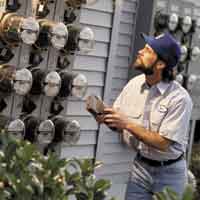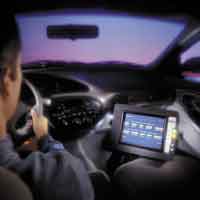Advanced metering technology is a problem-solver that a steadily increasing number of utilities are turning to in an unsafe world. A quality Automatic Meter Reading (AMR) system takes workers out of harm’s way, gives customers the privacy they increasingly expect, and saves gas, water and electric utilities from untold cost and hassle. Proclaiming safety as a priority is an important step. Embracing the technology necessary to follow through is sound business.

By using a handheld computer equipped with a radio, off-site meter reading systems or OMR, they’re called, enable meter readers to collect accurate meter data from a discreet distance without ever setting foot on the customer’s property.
Technology = Safety
At a basic level, AMR technology enables accurate and timely meter reading, and with unprecedented efficiency. This is accomplished via the installation of a radio-based meter module, called an ERT module, on a new or existing gas, water or electric meter. Readings are then collected by a meter reader using a handheld computer equipped with a radio, a vehicle-based radio device, or by a fixed network system. A meter reader using a handheld computer and walking a route can typically read up to 300 meters during an eight-hour shift. In contrast, a single meter reader equipped with a vehicle-based mobile computer can read up to 15,000 meters reliably and accurately during an eight-hour shift, without ever leaving the safe confines of his vehicle, and a meter reader equipped with a handheld computer can quickly capture readings from a sidewalk, as opposed to climbing over fences or entering homes.

From bad dogs to irate customers, traditional manual meter reading operations, which require the utility meter reader to physically access the customer’s property and visually read the meter, expose the meter reader to a variety of dangers, and the utility to lost productivity and potential liability.
A Dangerous Occupation
Prior to becoming manager of regulatory affairs for Itron, Emmett Kelly spent more than 23 years at Baltimore Gas and Electric, concluding his tenure as manager of field meter services. But it was the way he began his career, as a meter reader, that made a lasting impression. “People don’t realize how dangerous that job is,” says Kelly. “I learned very quickly to watch my back.”
That’s the unfortunate truth for most meter readers. Once a worker leaves his vehicle and ventures onto a metered property, bad things can happen. In many parts of the country, winter, with the accompanying snow and ice, makes every step an adventure.
Obtaining a reading is not always as simple as looking at a meter register on the side of a home. In parts of the West, most water meters are pit-set, meaning meter readers must risk contact with scorpions and other critters inside the pit just to do their job. In parts of Texas and the Southwest, the proliferation of aggressive “Africanized” killer bees is the latest worry for meter readers and other businesses with people working out in the field. In the case of meters located inside a home, often in a basement, the chance of injury is high. “Not only do you have to walk a staircase into a place where the homeowner might never even go, but you have rats and even fleas in some of those basements,” says Kelly. “That’s no fun, and it’s why meter readers appreciate AMR.”
The Salt River Project (SRP) in central Arizona had excellent reasons, not unique to its own operation, for making a change to AMR. “A major factor was dogs,” says Tom Stringer, meter reading manager for SRP. “You’re not always talking about friendly pets. A lot of the dogs our meter readers encountered on their routes were trained for protection. You can’t expect them to distinguish between a meter reader and an intruder.” According to Stringer, SRP used to average roughly one dog-related injury to a meter reader per month.
Stringer says SRP’s other key concern had to do with the rougher areas meter readers had to enter on foot. “There were places the police wouldn’t even go without backup, and we had meter readers walking around in there,” says Stringer. “Especially in the older areas of town, there’s a high turnover rate – lots of apartments and places like that – and you never know what to expect from one reading cycle to the next. A couple of our guys even had guns pulled on them. Thankfully, nobody pulled the trigger. But there’s no worse wake-up call.”
Those considerations led SRP to adopt an Itron mobile AMR system for hard-to-read electric meters and hazardous properties, giving meter readers in targeted areas the peace of mind that comes with doing their job from the security of a van. The 55,000-meter project is nearing completion, with positive results.
“It’s gotten a lot better. We’ve had fewer dog incidents, for one thing,” says Stringer. “I think it’s definitely because of AMR.” The utility plans to continue installing ERT modules on properties that are flagged as being hard-to-read or dangerous for one reason or another. Says Stringer, “It’s not worth it to us to take chances. If a meter reader brings a hazardous property to our attention, we’ll put an ERT module on the meter.”
SRP switched to AMR largely for concerns of the urban variety, but Kelly and Stringer each point out that rural areas are no picnic either in terms of safety. “You have the same problems accessing customer properties, and you have, in many cases, animals that are allowed to roam freely,” says Kelly. “If anything, meter readers in the country need to be even more alert. It’s no place to let your guard down.”
Painful Expense
Nobody likes to see a meter reader or anyone else get hurt. That’s the best reason to ensure added safety via AMR technology. But there are other crucial motivations to consider, such as the expenses that follow an injury. Costs multiply in a hurry, hampering a utility’s ability to carry out its most basic functions.
First, and most obvious, are medical costs and workers’ compensation. Whenever a field worker needs short-term or extended treatment, his utility, in most cases, foots the bill.
Legal costs can also take a toll, since accidents must be reported to a utility’s attorneys. Some are on retainer, while others are part of a city or county government. Either way, their time and expertise do not come cheap. And what if a legal issue arises after an accident, such as a meter reader suing his employer? Or what if, in the course of an accident, a meter reader causes destruction of property, leading a homeowner to take legal action against his employer to recoup damages? Such scenarios become reality all too often.
Lost work time is a problem not only in terms of cost, but also to the operation as a whole. “When people are out, it affects your ability to read routes on the schedule you’ve laid out, which is your most important goal,” says Kelly. “It also impacts the supervisor who has to spend his time filling out reports and investigating instead of making sure the process is running smoothly."
Also, with the efficiency enabled by a mobile AMR system, many fewer utility vehicles are required, diminishing the chances of dangerous and expensive automobile accidents.
Safe workers are an immensely worthwhile human reward of AMR technology, but the financial rewards are nearly as powerful.
Customers On Guard
It’s a given that a utility customer, if presented with a choice between continuing to see a meter reader in his yard, on his porch, or in his basement or, instead, watching him simply drive by in a van, will choose the latter. Part of the reason is safety. Instances of criminals gaining entry to homes by claiming a need to inspect a meter do happen. Most utilities have at least minor safeguards in place, such as identification badges for meter readers. But if a utility can take away the possibility of a misunderstanding or unfortunate incident by letting customers know that access to their property is no longer required, the potential liability for everyone involved is dramatically reduced, while customer security and satisfaction increases.
Stringer agrees, adding that the technology also strengthens relationships with customers. “One thing that’s overlooked about AMR is the customer service aspect. When people know you’ve taken steps to ensure that they don’t have to be bothered, they’re happy.”
Recent terrorism-related events have raised the stakes considerably, spawning a renewed emphasis on personal safety, bad news for utilities sending meter readers into the field. “People are more leery now,” says Kelly. “When that happens, the job gets tougher, because the natural response is to buy more dogs and alarm systems and things like that. I’ve heard cases of people buying surveillance cameras for their property.” Kelly adds that these measures seem most pronounced among elderly customers, who often feel especially vulnerable.

In addition to providing dramatic improvements in meter reading accuracy, speed and efficiency, mobile AMR systems such as the Itron DataPac, enable meter readers to gather reads automatically from the safety of a vehicle. It’s as simple as driving down the street.
Utilities everywhere are finding out that the AMR business case extends far beyond the hard costs associated with manual meter reading operations. The financial upside that comes with increased customer satisfaction, increased safety for workers and customers alike, and reduced potential liability can solidify an already-strong business case for AMR technology by greatly reducing or eliminating many of the risks inherent in traditional manual meter reading operations.
About the Author
Dan Benelisha is a marketing communications specialist for Itron Inc. in Spokane, Washington. Contact him at dan.benelisha@itron.com.







